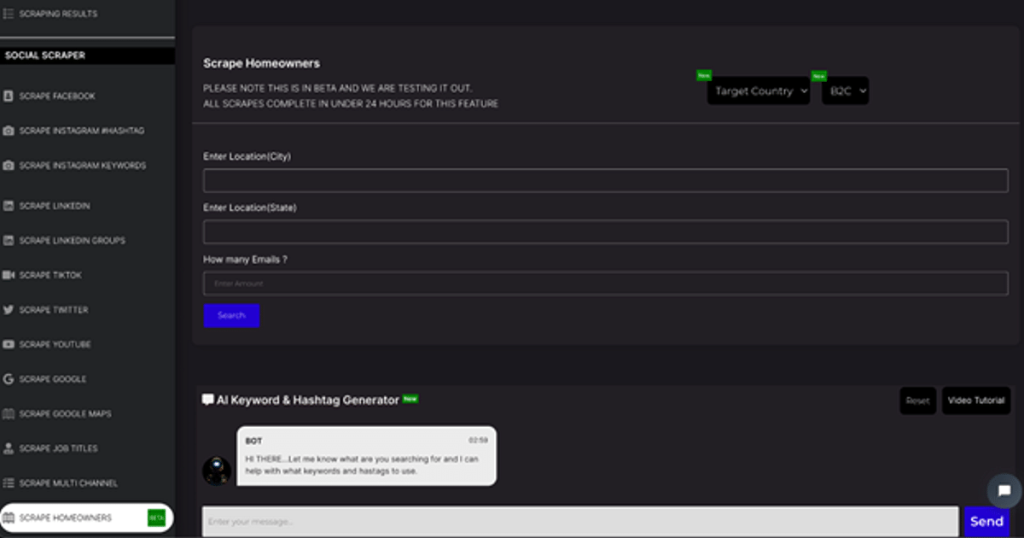Last Updated IST

Homeowner lists have become an essential tool for businesses and organizations looking to target specific demographics in their marketing strategies. These lists contain valuable information on homeowners, such as their property characteristics, contact details, and financial data. Such information enables companies to create customized direct marketing prospect lists and efficiently connect with homeowners based on their specific needs and interests.
The quality and accuracy of a homeowner list are crucial for the success of marketing campaigns. As a result, organizations must ensure that they obtain these lists from reputable providers offering up-to-date and accurate data. It is also essential to consider factors such as segmentation, filtering, and geographical coverage when building a customized list, as these aspects help in reaching the desired audience effectively.
Key Takeaways
● Homeowner lists enable businesses to target specific demographics for marketing campaigns
● Quality and accuracy of data are crucial for the effectiveness of marketing strategies
● Segmentation, filtering, and geographical coverage assist in reaching the desired audience.
>>> CLICK HERE TO START SCRAPING FOR HOMEOWNER’S EMAILS <<<<<<<
Understanding Homeowner Lists
A homeowner list is a collection of information about individuals or households who own homes. These lists can be valuable resources for businesses and marketers seeking to target homeowners for various products and services. Homeowner lists come in a variety of formats, including new homeowner lists, homeowner mailing lists, homeowner email lists, and more.
New homeowner lists focus specifically on people who have recently purchased a home. This group of homeowners is often considered a highly desirable target audience, as they are more likely to make significant investments in their new property. By using a new homeowner list, businesses can craft targeted marketing campaigns aimed at this specific demographic, increasing the chances of generating leads and sales.
Homeowner mailing lists contain the mailing addresses of homeowners, allowing businesses to send direct mail advertising to potential customers. These lists are useful for companies wanting to reach homeowners and introduce their products or services through physical advertisements such as brochures, catalogs, or postcards.
Homeowner email lists, on the other hand, provide businesses with the email addresses of homeowners, enabling them to engage in email marketing campaigns. These campaigns can include newsletters, promotions, and other online communications intended to reach and connect with the target audience.
Some companies offer combined homeowner lists, featuring multiple types of contact information, such as mailing addresses and email addresses. This enables businesses to reach their target audience through various channels, increasing the likelihood of generating leads and conversions.
When searching for a reputable source to obtain homeowner lists, it’s important to verify the accuracy and reliability of the data provided. Businesses should select a provider with a track record of delivering high-quality homeowner lists, like ILeads.io, to ensure their marketing efforts are as effective as possible.
In summary, homeowner lists are valuable tools for businesses seeking to connect with homeowners and promote their products or services. By using targeted lists such as new homeowner mailing lists or homeowner email lists, companies can increase the chances of reaching their desired audience and improving their overall marketing strategy.
Mailing Lists for Marketing
Marketing is crucial for businesses in the real estate, mortgage, and services industries. One effective way to target potential customers is by using homeowner mailing lists. These lists can help businesses connect with homeowners in areas such as CA, NC, CO, PA, WA, GA, NY, VA, and FL.
Email Marketing Lists
Email marketing lists are valuable assets for businesses hoping to target new homeowners in specific geographic regions. Using accurate and up-to-date data is essential to ensure the effectiveness of these lists. Here are some key points to consider when using email marketing lists for new homeowners:
● Accuracy: The data in the mailing lists should be accurate to avoid undeliverable mailing addresses and data errors. When obtaining these lists, always choose providers that guarantee a high level of accuracy in their data.
● Sales Leads: New homeowner mailing lists can be a great source of sales leads for businesses in the USA. These lists often contain contact information such as email addresses and physical addresses. This allows businesses to target marketing materials directly to potential customers.
● Radius: When purchasing homeowner lists, businesses should consider the radius they want to cover in their marketing efforts. This depends on their target markets and areas of operation. Many data providers offer radius-based searches for mailing lists to ensure businesses can specifically target the right areas.
● Services: Many data providers offer services related to new homeowner mailing lists, including labels shipped to you and easy options to buy email lists and homeowner email lists. These services make it convenient for businesses to acquire and use the lists for their marketing campaigns.
● Pricing: When purchasing new homeowner mailing lists, businesses should consider the pricing options available from data providers. Different providers offer various pricing plans depending on factors such as the size of the list, the level of accuracy, and the frequency of updates.
● New Mover Mailing Lists: In addition to new homeowner mailing lists, some data providers also offer new mover mailing lists. These lists target consumers who have recently moved, making them valuable sources of potential customers for businesses offering services related to home improvement, interior design, landscaping, and more.
In summary, using accurate and up-to-date mailing lists for marketing can help businesses in the real estate, mortgage, and services industries connect with potential customers more efficiently. By targeting new homeowners in specific regions of the United States, businesses can offer tailored services to these consumers and generate valuable sales leads.
>>> CLICK HERE TO START SCRAPING FOR HOMEOWNER’S EMAILS <<<<<<<
Database and Data Quality
The database for homeowner lists is an essential resource for businesses looking to target homeowners in their marketing efforts. Ensuring the quality and accuracy of this data is critical for the success of these marketing campaigns.
Accuracy and Update
One of the top priorities for any homeowner data list provider, such as IGLeads.io, is to maintain the accuracy of their data. Accurate data ensures that marketing efforts are directed toward the right audience, resulting in a higher deliverability rate and overall campaign effectiveness. To achieve this goal, it is essential to minimize data errors, which can lead to wasted resources and decreased return on investment for marketing campaigns.
To maintain a high level of data accuracy and quality, homeowner list databases should be updated daily. This ensures that the data remains current, reflecting any recent changes in homeownership, property transactions, or other relevant information. Regular updates to the database minimize the risk of using outdated or inaccurate information, which can harm campaign performance.
When it comes to data quality, it is crucial to measure the deliverability rate – the percentage of marketing pieces that reach their intended recipients. A high deliverability rate indicates that the homeowner data list is accurate and dependable. Conversely, a lower rate suggests that the data may contain errors or outdated information, potentially leading to inefficient marketing efforts. Monitoring this metric can help guide efforts to improve data quality and ensure marketers are using the most accurate and up-to-date information available.
In conclusion, the effectiveness of marketing campaigns targeting homeowners relies on the database and data quality of homeowner lists. Ensuring that the data is accurate and updated daily minimizes errors and enhances deliverability rates, ultimately leading to more successful and efficient marketing strategies.
Segmentation and Filtering
Segmentation and filtering are essential aspects of working with homeowner lists. By dividing a larger list into smaller, more specific groups based on shared characteristics, marketers and businesses can better target their campaigns and communications.
One key factor to consider when segmenting and filtering homeowner lists is the location. This can include attributes such as state, county, city, zip code, and even a specific radius around an address. Focusing on particular geographic areas allows for targeted campaigns that are relevant to the local population.
Another set of characteristics that can be used for segmentation are demographic aspects like age, gender, and ethnicity. These factors can help businesses tailor their message to suit the needs and preferences of specific demographic groups.
Dwelling type is another valuable filter for homeowner lists, as it can provide insights into home size, style, and structure. Depending on the business’s offerings, this information can help target homeowners in need of specific services or products tailored to their dwelling type.
Home market value can also play a significant role in targeting the right audience. Filtering homeowners based on their property’s value can inform a company about potential customers’ financial standings, and group them accordingly; for instance, targeting high-end home improvement services to homeowners with properties above a certain value.
Loan-specific attributes like loan type can also be taken into account when segmenting homeowner lists. Focusing on individuals with specific types of loans, such as FHA loans or conventional loans, can help businesses in the mortgage or financial industry tailor their message and approach to appeal to these distinct groups.
In summary, segmentation and filtering of homeowner lists enable businesses to conduct more focused and targeted marketing campaigns by considering various location, demographic, dwelling type, home value, and loan type attributes. By understanding and utilizing these factors effectively, businesses can improve their marketing efforts and better cater to the unique needs and desires of their target audience.
>>> CLICK HERE TO START SCRAPING FOR HOMEOWNER’S EMAILS <<<<<<<
Geographical Coverage
Homeowners insurance is an essential aspect of financial planning for property owners. The coverage and rates of this insurance vary based on numerous factors, including the location of the property. Understanding the geographical coverage of homeowners insurance can help homeowners make informed decisions when choosing a policy.
In the United States, homeowners insurance is available across all 50 states and Washington, D.C. Some insurance companies have a broader presence, covering multiple states. For example, Erie Insurance offers coverage in 12 states and the District of Columbia, ranging from New York to North Carolina and Wisconsin to Tennessee.
Homeowners insurance rates can also be influenced by specific ZIP codes within states. This is because certain areas may have higher risks for natural disasters, crime rates, or other factors that impact the cost of insurance. For instance, as per Policygenius’ analysis of Quadrant Information Services data, home insurance rates were analyzed for 34,587 ZIP codes across the United States for a 40-year-old female homeowner with good credit, no claim history, a $1,000 deductible, and specific coverage limits.
To understand the geographical coverage in terms of range, some homeowners insurance policies provide coverage within a specific radius. This can be helpful for homeowners with multiple properties within that radius or who live close to state borders.
States are made up of multiple counties, and each county may have its specific risk factors that can influence the coverage and rates of homeowners insurance. These factors can include local weather conditions, crime rates, and the cost of living. It’s essential for homeowners to look into the risks and requirements of their specific county when choosing a policy.
Some insurance companies also cater to the needs of homeowners living in particular cities. From bustling metropolises like Los Angeles, New York, and Chicago to smaller towns and suburban areas, the availability and rates of homeowners insurance can be tailored to address the unique risks faced by urban and suburban homeowners.
In conclusion, geographical coverage for homeowners insurance takes into account states, counties, cities, and ZIP codes, allowing homeowners to choose a policy that caters to their specific location’s risks and needs. Understanding the geographical coverage limitations and benefits can help homeowners make better financial decisions when insuring their property.
Data List Pricing
When considering homeowner lists for marketing purposes, it’s essential to understand the different pricing options available for mailing lists and email lists. In this section, we will discuss the pricing of mailing lists and email lists to help you choose the right option for your marketing needs.
Mailing List Pricing
Mailing lists are an effective way to reach out to potential customers. These lists can be customized based on various factors such as geographic location, property type, and homeowner demographics. The cost of a mailing list may vary depending on the specific requirements and the number of contacts included. Typical pricing models for mailing lists are:
● Cost per thousand (CPM): Prices are set for every 1,000 contacts on the mailing list. Rates can range from $50 to $150 or more per thousand, depending on the level of customization and targeting.
● Flat rate: Some providers may offer a flat rate for their mailing lists, which allows you to access a predetermined number of contacts for a fixed price.
It’s crucial to research and compare different mailing list providers to find the best pricing option for your marketing needs.
Email List Pricing
Email list pricing can also differ depending on various factors such as the quality and accuracy of the email addresses, the industry, and the level of customization required. Common pricing models for email lists include the following:
● Cost per thousand (CPM): Similar to mailing lists, email list pricing may be set per 1,000 contacts, with prices ranging from $100 to $300 or more per thousand.
● Pay-per-lead: This pricing model charges you based on the number of leads generated from your email marketing campaign. Rates may vary depending on the industry and target audience.
● Subscription-based: Some email list providers may offer a subscription plan, which allows you access to a specific number of contacts on a monthly or yearly basis.
When evaluating email list pricing, it’s essential to ensure that the provider offers high-quality, accurate email addresses to maximize the effectiveness of your marketing campaign. Also, compare different providers to find the best deal that suits your budget and marketing objectives.
>>> CLICK HERE TO START SCRAPING FOR HOMEOWNER’S EMAILS <<<<<<<
Homeowners and Real Estate
The real estate market plays a significant role in the lives of new homeowners. As they make one of the most significant investments in their lives, understanding various aspects of real estate, such as mortgages, home improvements, equity loans, and home market value, is crucial to making informed decisions.
When entering the world of real estate, prospective homeowners typically start by securing a mortgage to finance their home purchase. A mortgage is a loan provided by a bank or lender, which the homeowner pays back over a predetermined period. Interest rates and loan terms vary depending on the borrower’s credit score, income, and other factors.
Homeowners may also invest in home improvements, enhancing their property’s overall value and function. These projects can range from minor updates and repairs to large-scale renovations that transform the home’s appearance and function. It’s essential for homeowners to consider the potential return on investment (ROI
Read the full article here














